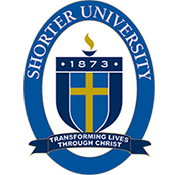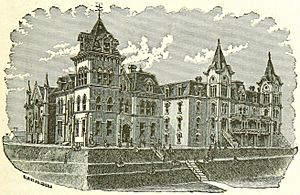Shorter University facts for kids
 |
|
|
Former names
|
Cherokee Baptist Female College (1873–1877) Shorter Female College (1877–1948) Shorter College (1948–2010) |
|---|---|
| Motto | Transforming Lives Through Christ |
| Type | Private university |
| Established | 1873 |
|
Religious affiliation
|
Georgia Baptist Convention |
| Endowment | US$ 27 million |
| President | Donald Dowless |
| Provost | John D. Reams |
|
Academic staff
|
388 |
| Students | 1,410 |
| Undergraduates | 1,306 |
| Postgraduates | 104 |
| Location |
,
,
United States
34°15′29″N 85°11′46″W / 34.258°N 85.196°W |
| Campus | Suburban |
| Colors | Columbia blue, white and gold |
| Nickname | Hawks |
|
Sporting affiliations
|
NCAA Division II – Gulf South |
| Mascot | Harold the Hawk |
 |
|
Shorter University is a private university located in Rome, Georgia. It is connected with the Georgia Baptist Convention. The university was started in 1873.
Shorter University offers many different degrees for students. These degrees are available through its six colleges and schools. The university also has special facilities in the Rome area for its business and nursing programs.
The university's sports teams are called the Shorter Hawks. They are part of NCAA Division II and the Gulf South Conference. The school colors are blue and white.
Contents
History of Shorter University
How Shorter University Started
Shorter University began in 1873. It was first a college just for women. It was called the Cherokee Baptist Female College. A pastor named Luther Rice Gwaltney started it.
In 1877, the college changed its name. It became Shorter Female College. This was to honor Alfred and Martha Shorter. They gave a lot of money to help the school.
The college was first located on Shelton Hill in Rome. It taught young women from elementary to college levels. Classes were held Tuesday through Saturday. Early subjects included science, music, art, and drama.
Moving and Growing the Campus
Thanks to more donations, the university moved in 1910. It moved to its current location outside Rome. In the 1920s, Shorter built the first indoor swimming pool in the United States. Swimming became a required class for graduation.
During this time, women were also chosen for the Board of Trustees for the first time. Shorter also became an accredited member of the Southern Association of Colleges and Schools. This means it met high standards for education.
Facing Challenges and Strengthening Academics
The college faced tough times in the 1930s during the Great Depression. It also struggled during World War II in the 1940s. The president, Paul M. Cousins, and the teachers even took pay cuts to help the school.
Academics got stronger when the college joined the National Association of Schools of Music. This helped improve its music programs.
Becoming Co-Educational and More Diverse
In the 1950s, Shorter College started letting both boys and girls attend. This is called being co-educational. Because of the new male students, a new dorm just for boys was built.
The university also started intercollegiate sports teams. These teams joined the NAIA. New clubs, groups, and fraternities also began.
Randall Minor became the college's 14th president in 1958. Under his leadership, the Georgia Baptist Convention gained more control over choosing trustees. The college built new buildings, including an administration building, student center, and library. More teachers were hired as the school grew. The late 1950s also saw the first African-American student graduate.
Expanding Programs and Name Change
The 1990s brought new international programs. The university also expanded its MBA programs and adult education. This happened with the creation of the School of Professional Programs in the Atlanta area.
Shorter College built new facilities like the Winthrop-King Centre and the Fitton Student Union. They also built new apartments for students and a welcome center. The Robert H. Ledbetter baseball field was also constructed.
In 2010, Shorter College changed its name to Shorter University. This new name showed how much the school had grown and expanded its programs. In 2012, Shorter University's accreditation was confirmed again until 2022.
Campus Life at Shorter
Shorter University has a large campus. It covers 155 acres in Rome.
Shorter also offers many online degrees. Students can earn associate's, bachelor's, and master's degrees from home.
Academics and Degrees
Shorter University offers many different study programs. Students can earn bachelor's degrees in 30 different subjects. They can also get some master's degrees.
Shorter Hawks Athletics
The sports teams at Shorter University are known as the Hawks. They compete in NCAA Division II. Most of their sports teams are part of the Gulf South Conference (GSC). However, their track and field teams compete in the Peach Belt Conference (PBC).
Before joining NCAA Division II, the Hawks were part of the National Association of Intercollegiate Athletics (NAIA). They competed in the Southern States Athletic Conference (SSAC).
Sports Offered at Shorter
Shorter University has 22 different varsity sports teams.
- Men's sports include baseball, basketball, cheerleading, cross country, football, golf, lacrosse, soccer, tennis, and track & field.
- Women's sports include basketball, cheerleading, cross country, golf, lacrosse, soccer, softball, tennis, track & field, and volleyball.
Recent Athletic Achievements
In May 2011, Shorter decided to join NCAA Division II. They were accepted in July 2011 and joined the Gulf South Conference in July 2012. By summer 2013, they became a full provisional member of NCAA Division II.
In their last year in the NAIA, Shorter University's athletics program was ranked second nationally. This was their highest ranking ever. The Hawks scored points in 12 sports. They won national championships in softball and men's outdoor track and field. The men's outdoor track team won for the second year in a row.
Shorter also placed second in men's indoor track and field. They finished third in men's basketball and fourth in women's indoor track and field. The women's golf team finished fifth. These achievements helped Shorter leave the NAIA with a strong record.
Notable Alumni
- Vivian Louise Aunspaugh, a painter and art teacher from Texas
- Jamie Barton, an opera singer
- Marilyn Lloyd, a businesswoman and politician from Tennessee
- Anthony O'Garro, a professional soccer player
- Martin Scott, a businessman, educator, and politician
- Moeed Yusuf, the 9th National Security Adviser to the Prime Minister of Pakistan



